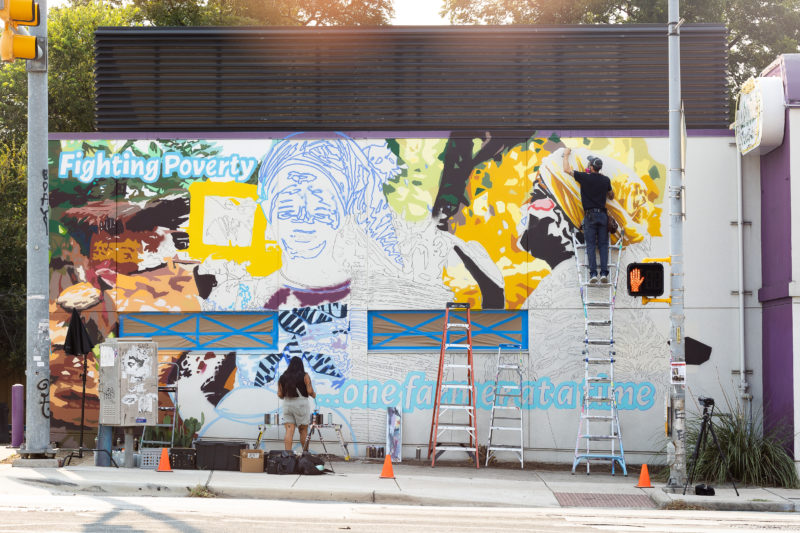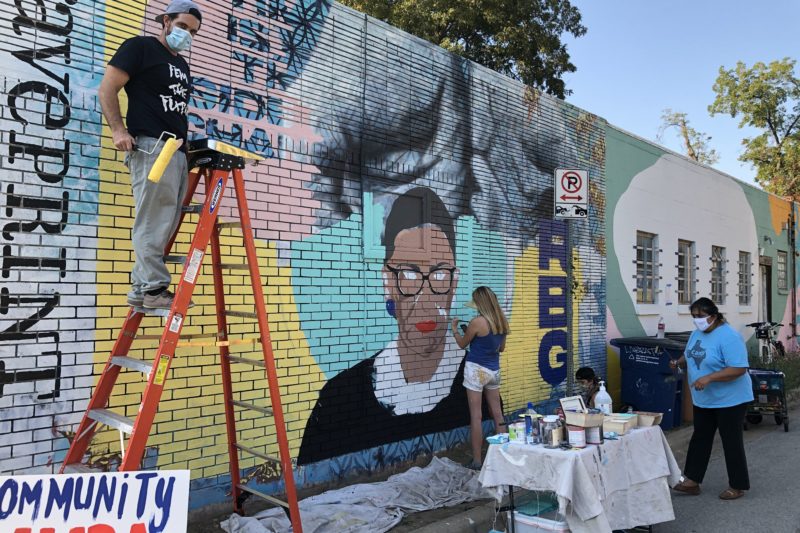Austin Muralists Explore ‘Works of Consequence’
By Lauren Goodman
Reporting Texas

Muzacz works on a mural outside of Wheatville Food Co-op for Fairtrade America. (Courtesy of J Muzacz)
From the “I Love You So Much” script on the side of Jo’s Coffee on Congress Avenue to the “Greetings from Austin” postcard mural on South First Street, Austin’s most recognizable murals have become spots for newcomers and locals to photograph and post on their Instagram feeds.
Throughout the past year, local Austin artists have also used their work to speak on the political climate, race and world issues, ultimately wanting their art to connect people from all walks of life.
Exploring Identity
Soledad Fernandez-Whitechurch, a freelance artist, tends to think of her art as an exploration of the past, present and possibility. Growing up in Argentina, Paraguay and the United States, she struggled to navigate her identity.
“I happen to think of that identity as three different segments of one person,” Fernandez-Whitechurch said. “That, in a way, turned into making art about past, present and possibility because I like to think of the future. Instead of this linear track that you’re already on … rather a possibility where everything is open-ended and anything can happen. You can be anything.”
After the death of U.S. Supreme Court Justice Ruth Bader Ginsburg in September 2020, Fernandez-Whitechurch felt a deep sadness and loss as she looked up to Ginsburg for her work ethic and humility.
“When she passed away, there was a sense of loss of someone gone that was so special and so unique to so many women,” Fernandez-Whitechurch said. “And so I gave myself permission to cry for a day or so. And then I wanted to do something that inspired others.”

Austin locals join Fernandez-Whitechurch in community painting. (Courtesy of Soledad Fernandez-Whitechurch)
Fernandez-Whitechurch invited the East Austin community to help paint a mural on East Cesar Chavez Street to honor Ginsburg’s legacy. To her, the mural was “symbolic handholding” of the community.
Driving by the mural a few months later, Fernandez-Whitechurch noticed stickers that adorned Ginsburg’s white-painted collar. As she got closer, she realized that they were “I Voted” stickers.
“It was incredibly moving,” Fernandez-Whitechurch said. “That is probably the coolest thing that ever happened.”
More recently, she worked on another mural for the Women & Their Work organization right next to the Ginsburg mural. In both murals, Fernandez-Whitechurch continues to pay homage to her heritage with vibrant blue and yellow.
“It’s a little wink and a nod in my art because that is the color of the soccer team that I follow in Argentina and where my grandfather played,” Fernandez-Whitechurch said. “A wink to a color that in my country people recognize right away, but in the United States, they don’t, so there’s that little playful element.”
Fernandez-Whitechurch said there’s a sense of collective success in Austin as artists and community members continue to create opportunities to showcase others’ work. Nearly a year later, Fernandez-Whitechurch said it speaks volumes that the RBG mural has never been defaced.
“I’m sure there are a lot of people who see that mural, and they don’t agree with what Ruth stood for,” Fernandez-Whitechurch said. “And yet, no one has been disrespectful or destructive … That even though the times are what they are now, Texas and Austin are places where people are kind and they’re generous and we respect each other. We have a lot more in common than we realize.”
Starting a Dialogue
One could say that artist J Muzacz’s first murals in Austin started when he was 19 in high school doing street art. When he was limited by the size of the space he could paint on, he went door-to-door to ask business owners if he could use their outside walls as a canvas.
Muzcaz remembered saying, “‘You got a nice wall there, you mind if I do something?’”
“When you’re a young age as the kid with something to express then graffiti and street art is a good medium to start, but I didn’t want to vandalize,” Muzacz said. “I was like, ‘Let’s see how this goes.’ Can I make a living at this? Can I sell artwork? And, you’re never really sure.”
Muzacz’s art career eventually evolved years abroad and in Texas as he has taken on various teaching jobs through the years: teaching English abroad in South Korea and Japan, teaching urban art to children at the Austin Recreation Center and working as an art teacher at a Dripping Springs school.
“With each new job, I’m always learning something,” Muzacz said. “For me, the scale is exciting, the collaborative nature of both collaborating with your clients or the community or fellow artists, those are all very exciting sort of environments to be in as a creative.”
Muzcaz’s world experiences came in handy in his most recent mural in September when Fairtrade America commissioned him to paint a mural outside of the Wheatsville Food Co-op on Guadalupe Street to raise awareness about farmers and supply chain workers who have historically been taken advantage of by large corporations.
As someone who has worked in the past in sugarcane harvesting, on mango farms and in vegetable gardening, Muzcaz agreed to the project.
“I’ve only done it for seasons here and there, and these women, a lot of them, do it their whole lives,” Muzcaz said.
Muzacz researched and used the stories of female farmers in Ghana and the Ivory Coast. Muzacz said he chose to showcase BIPOC, or Black Indigenous People of Color, women who historically have not been depicted fairly and equitably in public art. In this way, Muzacz seeks to even the scale of representation in public art.
“I selected those women specifically because their stories of strength and perseverance resonated with something I wanted to share,” Muzcaz said. “These women are modeling a change for the better, for more equitable representation in the farming communities there and exhibiting fantastic leadership.”
Muzacz believes there is not enough art in Austin, and that artists should hold each other accountable for their work.
“I also want to make work of consequence — work that either educates, inspires a bliss or at least provokes a dialogue,” Muzacz said. “Something besides shallow meaningless design work.”
Representing the Underrepresented
Chris Rodgers, a freelance muralist, is no stranger to Austin’s art scene. His artwork such as his downtown Austin mural honoring George Floyd and Black Americans killed by police, “If HE Can’t Breathe, WE Can’t Breathe,” has been recognized in numerous publications.
His other work within the past year includes a mural featuring Gary Clark Jr. and a little girl outside the Austin FC stadium to the mural about the Historic Victory Grill depicting a jazzy scene honoring legendary Black artists.
His art, Rodgers said, is all about reflecting the East Austin community and depicting marginalized groups that are underrepresented or forgotten.
“Growing up in South Carolina, biracial, very aware of race relations, it never fully sank into me how potent images are,” Rodgers said. “And to be represented — to bring something back into the present right now physically is so much more than just a picture, it gives people a foundation to hold onto.”
Rodgers said showcasing diversity in his art also came from his experience as a recovering alcoholic as he got to know others in the Austin community struggling with addiction.
“The beautiful thing that I’ve learned in recovery is that the people that I come across, a spectrum of people that I normally wouldn’t mix with, but just by virtue of our collective experience in addiction, and in recovery,” Rodgers said. “There’s something so potent about that, and so that’s what I try to bring into my art as well.”
Rodgers said his move from South Carolina to Austin was motivated by his need to be in a community of other creators. When he sometimes gets caught up in his own work, he is reminded by his friends that creative expression is meant to be fun.
“I wanted to be around people that create and I’m not just talking about painters,” Rodgers said. “If you’re passionate about churning butter, guess what? That is going to make me want to paint that immediately. We need each other to create. Wherever that creativity comes from — it’s conducted through us.”